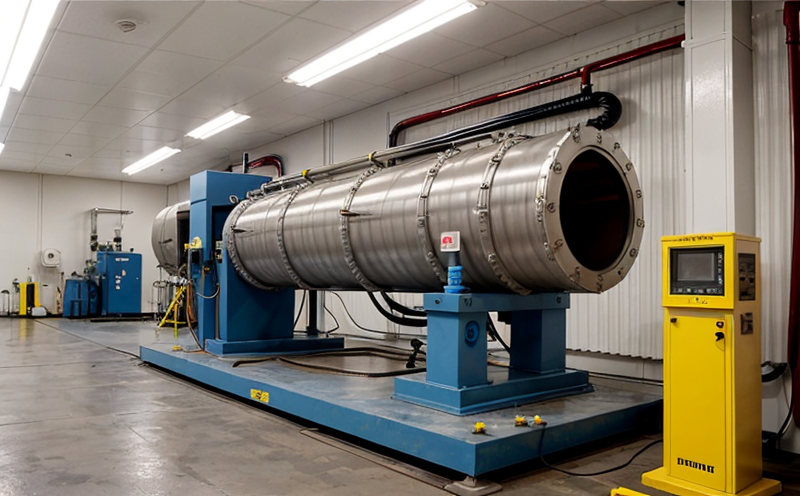ASTM C1350 Examination of Spent Fuel Microstructure
The ASTM C1350 examination is a critical process used in the nuclear industry to evaluate the microstructural changes that occur during the irradiation and subsequent cooling of spent nuclear fuel. This service plays an essential role in ensuring the safe handling, storage, and disposal of nuclear waste by providing insights into the integrity and quality of the fuel assemblies.
The examination is conducted using advanced scanning electron microscopy (SEM) with energy-dispersive X-ray spectroscopy (EDS). SEM allows for high-resolution imaging, while EDS provides elemental analysis. This dual approach ensures a comprehensive understanding of microstructural changes such as grain size distribution, phase composition, and defect formation.
The ASTM C1350 examination process is highly detailed and involves several key steps:
- Sample Preparation: The spent fuel rods are carefully cut into small sections that can be analyzed under the SEM. This process requires precision to ensure representative samples without introducing artifacts.
- Microstructural Analysis: Using SEM, detailed images of the fuel's microstructure are captured at various magnifications. EDS is then used to identify specific elements present in these structures, providing elemental mapping and depth profiles.
- Data Interpretation: The collected data is analyzed by experienced technicians who interpret the results against established standards such as ASTM C1350. This analysis helps determine if the fuel meets quality criteria for reprocessing or disposal.
The significance of this examination cannot be overstated, especially in the context of nuclear safety and regulatory compliance. Understanding the microstructural changes allows operators to make informed decisions about fuel management strategies, which can enhance operational efficiency while minimizing environmental risks.
Some key points to consider when undergoing an ASTM C1350 examination include:
- The importance of proper sample preparation to avoid introducing errors in the analysis.
- The role of advanced microscopy techniques in providing detailed insights into fuel integrity.
- The necessity for experienced personnel to interpret results accurately and consistently with industry standards.
By adhering strictly to ASTM C1350 guidelines, laboratories can ensure that their findings are reliable, reproducible, and aligned with international best practices. This not only supports the nuclear industry's goals but also contributes significantly to global safety and environmental protection efforts.
Why It Matters
The ASTM C1350 examination is crucial for several reasons:
- Regulatory Compliance: Nuclear fuel testing must adhere to strict regulatory requirements, ensuring that all processes comply with international standards like ASTM C1350. This helps maintain a high level of trust and reliability within the industry.
- Safety Assurance: By examining spent fuel microstructures, potential safety hazards can be identified early, allowing for proactive measures to mitigate risks during handling and disposal.
- Operational Efficiency: Understanding the microstructural changes helps optimize fuel reprocessing techniques, leading to more efficient operations and reduced costs.
- Environmental Impact: Proper assessment ensures that nuclear waste is managed responsibly, minimizing environmental impact and contributing to sustainable practices.
The ASTM C1350 examination is a vital component of the nuclear fuel lifecycle, providing critical data needed for informed decision-making. It supports not only current operations but also future developments in nuclear technology.
Industry Applications
- Nuclear Fuel Reprocessing: The examination helps determine if spent fuel is suitable for reprocessing, ensuring that resources are used efficiently and safely.
- Degradation Monitoring: Regular examinations can monitor the degradation of nuclear materials over time, providing valuable data for long-term planning.
- Waste Management: Understanding microstructural changes aids in effective waste management strategies, ensuring that nuclear waste is handled safely and responsibly.
- New Material Development: Insights from ASTM C1350 examinations can inform the development of new materials for future nuclear applications, enhancing performance and safety.
The results of these examinations are used by various stakeholders in the nuclear industry, including regulatory bodies, power plant operators, and research institutions. This collaborative approach ensures that all aspects of nuclear fuel management are addressed comprehensively.
Competitive Advantage and Market Impact
The ability to conduct accurate ASTM C1350 examinations provides a significant competitive advantage in the nuclear industry:
- Trust and Reputation: Compliance with international standards enhances the reputation of laboratories, making them preferred partners for nuclear operators.
- Innovation Leadership: By staying at the forefront of testing technologies and methodologies, laboratories can influence future standards and practices in the industry.
- Premium Pricing Power: The expertise required to perform these examinations allows for premium pricing strategies, reflecting the high value added by this service.
- Strategic Partnerships: Leading-edge testing capabilities attract strategic partnerships with major players in the nuclear sector, fostering collaborative opportunities and growth.
The market impact of accurate ASTM C1350 examinations is substantial. They contribute to a safer and more efficient nuclear industry, driving innovation and sustainability. By adhering to these standards, laboratories play a pivotal role in shaping the future landscape of nuclear technology.





